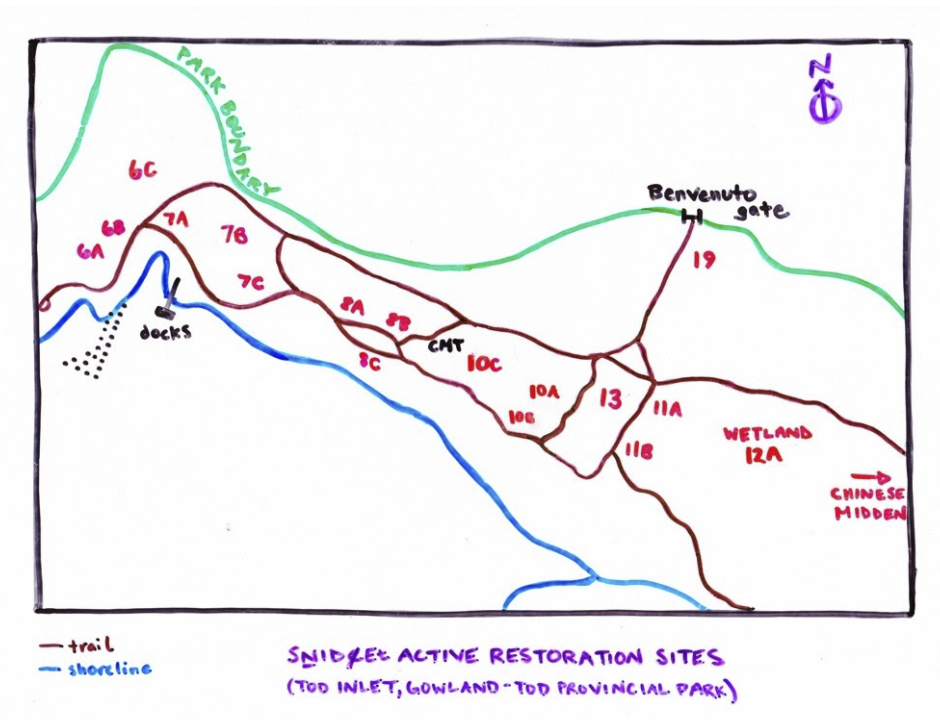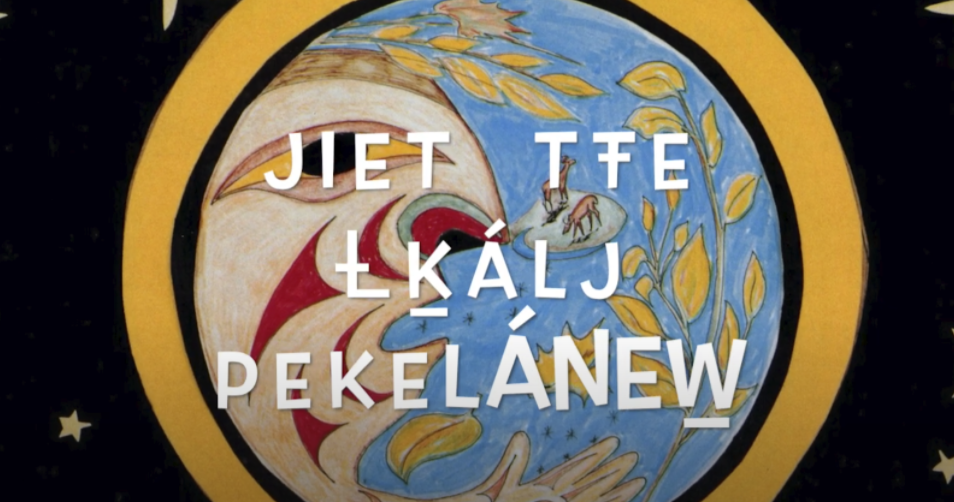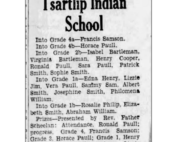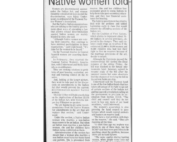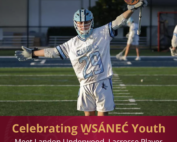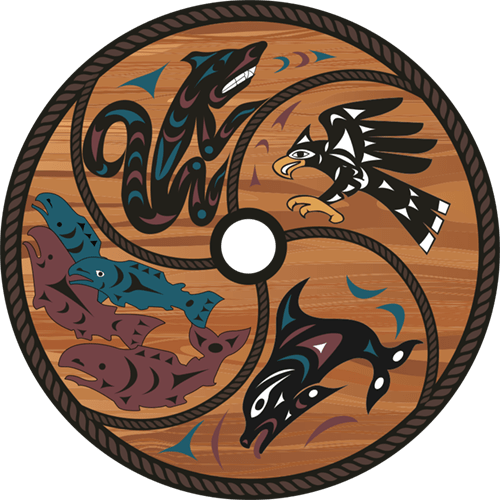WLC and PEPÁḴEṈ HÁUTW̱ Foundation explore collaboration to protect the natural ecology within W̱SÁNEĆ Territory.
The PEPÁḴEṈ HÁUTW̱ Foundation is a community organization active in the restoration of native ecosystems in important W̱SÁNEĆ places, as well as food systems education at ȽÁU,WELṈEW̱ Tribal School and beyond.
Shown above: PEPÁḴEṈ HÁUTW̱, or “Blossoming Place”, the native plant nursery, garden and centre for food systems education at ȽÁU,WELṈEW̱ Tribal School in W̱SÁNEĆ territory.
The PEPÁḴEṈ HÁUTW̱ Foundation has been operating out of the PEPÁḴEṈ HÁUTW̱ or “Blossoming Place” nursery and gardens onsite at ȽÁU,WELṈEW̱ Tribal School in W̱SÁNEĆ territory. PEPÁḴEṈ HÁUTW̱ Foundation team members include Judith Lyn Arney, PEPAḴIYE Ashley Cooper (from W̱JOȽEȽP), respected SȾÁUTW̱ elder Earl Claxton, and Sarah Jim (from W̱SIḴEM).
Their mission is to provide participatory education opportunities about traditional and healthy food systems at ȽÁU,WEL,ṈEW̱ Tribal School, to contribute to the restoration and revitalization of native ecosystems in the W̱SÁNEĆ homelands, and to promote food security and Indigenous food sovereignty in the W̱SÁNEĆ community and beyond.
The foundation fulfils their twofold education and restoration mission in several ways. Programming at the ȽÁU,WEL,ṈEW̱ Tribal School provides land-based learning workshops, bringing many secondary students to SṈIDȻEȽ for restoration work. In the past, PEPÁḴEṈ HÁUTW̱ hired two W̱LSS students, providing valuable work experience to add to their resumes. Before COVID-19, PEPÁḴEṈ HÁUTW̱ taught workshops for both elementary and high school students in person and on the land.
In addition to providing regular workshops and operating the native plant nursery, PEPÁḴEṈ HÁUTW̱ leads numerous ongoing restoration efforts at significant sites in W̱SÁNEĆ territory including:
- SṈIDȻEȽ (Tod Inlet, Gowlland-Tod Provincial Park) is the first W̱SÁNEĆ village site and where SLEMEW̱, the first W̱SÁNEĆ man, was placed by XÁLS the Creator.
- Onsite at the Tribal School! ȾIKEL (Maber Flats) was once prized as a gathering place for basketry and rope making materials. In connection with ȾIKEL we are restoring a wetland ecosystem around the school soccer field. The beautiful SX̱OLE (willow) is an important plant material for the construction of the traditional W̱SÁNEĆ reefnet.
- The W̱SÁNEĆ Ethnobotany Trail & Restoration Project, a partnership project between the PEPÁḴEṈ HÁUTW̱ Foundation and the Horticulture Centre of the Pacific (HCP). HCP is located in HELEṈIḴEN, named for the headwaters of many tributaries in this area.
- ȾIX̱EṈ (Cordova Spit), the sandy spit located at Tsawout First Nation, a unique and diverse shoreline ecosystem rich in traditional medicines.
PEPÁḴEṈ HÁUTW̱ has also led several shorter-term projects that brought together volunteers, staff and students alike. Last July, they led a restoration day that took place at QENENIW̱, the village site and reserve land on Pender Island. Lastly, the members of PEPÁḴEṈ HÁUTW̱ post frequent image and video updates on their social media, providing continuous access to W̱SÁNEĆ plant knowledge.
Over the last several years, the team at PEPÁḴEṈ HÁUTW̱ has provided important education to youth, community members, tourists and settlers alike, all while restoring the native plants and food systems that are foundational to W̱SÁNEĆ culture.
The WSANEC Leadership Council is thrilled to explore collaboration with the PEPÁḴEṈ HÁUTW̱ foundation in order to fulfil its mission of enhancing recognition of and respect for W̱SÁNEĆ Douglas Treaty Rights and W̱SÁNEĆ aboriginal rights and title.
The need for restoration of native plants and food systems is evident in several projects the W̱SÁNEĆ Leadership Centre has underway, specifically:
- The Fur to Forest initiative at the Gulf Islands National Park Reserve. This plan manages the reduction of invasive species, restoration of native plants and food systems and reduction of the fallow deer that currently overrun the Gulf Islands, posing fire risk and damaging the delicate ecosystem.
- The agreement with Transport Canada to ensure that the numerous contaminated sites on the Airport Land are remediated. This site is complex in that it contains multiple compromised waterways and areas of land that require careful management.
- Local Area Land Management Plans: The WLC is being asked to comment on local area plans being developed by municipalities, starting with Cordova Bay. The intention is to increase W̱SÁNEĆ community sovereignty, involvement in stewardship, native plant restoration and more.
Working together, the WLC and PEPÁḴEṈ HÁUTW̱ Foundation will increase the awareness and respect for WSANEC culture, reestablish appropriate conditions for plant relatives to thrive and help to bring back the ways of life that were almost lost.
To stay up to date on this story, please sign up for our newsletter.
Shown above: one of the newest videos added to theSENĆOŦEN YouTube Channel
The impact of providing comprehensive education in SENĆOŦEN goes far beyond linguistics. SX̱EDŦELISIYE explains, “With language immersion, the students are also immersed in the W̱SÁNEĆ worldview because the culture and language are inseparable. The children are then grounded in their ways of being, in their culture. They have a solid identity. EWES ṮEQ TŦE SONUSE – in this way we don’t let the fire go out.”
While much has been done, there is much still to do. Accordingly, a lot of resources are being allocated to support additional SENĆOŦEN programming. The W̱SÁNEĆ schools are currently expanding with a new wing in the works (preschool to grade six) and 4 more classes being added to the the W̱SÁNEĆ Leadership School. The dream is to extend the SENĆOŦEN curriculum into Grade 12 and beyond so the youth can be completely bilingual. To achieve this, SX̱EDŦELISIYE is working on a ladder from Grade 7-12, modelled after a charter school in Hawaii.
The hope is that immersion students will graduate high school and transition into the W̱,SENĆOŦEN,ISTW̱ program. This two-year language certificate program ladders into a SENĆOŦEN B.Ed, a program that has been running for 5 years. From there, the B.Ed can be applied to a Masters degree in language revitalization and finally a Ph.D. in education. SX̱EDŦELISIYE mentioned that she hopes to see the immersion cohorts continue their language journey and get their Ph.D’s with their strong foundation in SENĆOŦEN.
“It’s been 50 years or more since children have been speaking our language, it is our ĆELÁṈEN our birthright, it is in our DNA, and it it beautiful to hear our children speak, pray and sing in SENĆOŦEN once again. I’d really like to thank our W̱SÁNEĆ communities and family for participating in language revitalization and believing in the benefits of having your children immersed in SENĆOŦEN.
While a career in education is an obvious career path. SX̱EDŦELISIYE believes strongly there are many additional benefits to fluency SENĆOŦEN:
“Right now the language focus in post-secondary is in linguistics and education but it can and should expand into all areas of governance, law, health and wellness. We want to ensure EWES ṮEQ TŦE SONUSE / we don’t let the fire (language) go out in our people, we want our children/youth to walk proudly as W̱SÁNEĆ adults with a strong W̱SÁNEĆ identity.
SḰÁLS Ć,SE LÁ,E TŦE SELW̱ÁN, in the words from our Elders, it’s important to be gentle with those just starting to learn the language, ĆOȻES ȻENS TOLNEW̱, use what you know, start where you are with what you have.”
To stay up to date on this story, please sign up for our newsletter.
RECENT POSTS
How are we doing?
Their mission is to provide participatory education opportunities about traditional and healthy food systems at ȽÁU,WEL,ṈEW̱ Tribal School, to contribute to the restoration and revitalization of native ecosystems in the W̱SÁNEĆ homelands, and to promote food security and Indigenous food sovereignty in the W̱SÁNEĆ community and beyond.



